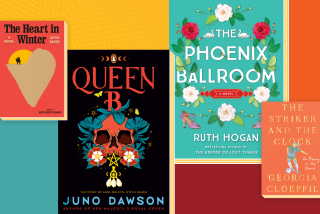Myths and folk tales are deceptively simple....
Myths and folk tales are deceptively simple. Passed down from generation to generation, they appear as polished as pebbles at the water’s edge; but each new storyteller has to know how to make the smooth stones skip.
The five stories reviewed here all are based on traditional tales. They illustrate a range of story styles and a variety of choices made by the authors, from a direct translation of an ancient tale to a patchwork cloth tailored by one author to suit his own mixed heritage.
A myth of creation is the logical starting place. Barbara Ker Wilson’s The Turtle and the Island (HarperCollins Children’s Books: $13.95; ages 4-9) explains how the land of Papua New Guinea was brought up from the bottom of the sea by a turtle, and how people came to live there. The naive paintings by Frane Lessac in clear colors evoke the sun-washed land newly anchored in an ocean teeming with cheerful schools of fish.
“The Turtle and the Island” is a classic type of creation myth that begins not with creation from nothing but with a creature who existed in the beginning of time. Furthermore, the people already exist, too; the turtle just brings the man up from a cave under the sea, where it was dark, and the woman from a far island, where she was lonely. They are happy on the new island, and populate it with their children.
Wilson curiously chooses to tell the story as an outsider. For Papuans, the story explains how the whole world as they know it began, as surely as Genesis tells us. But Wilson keeps her distance from that world, always reminding us that it is just a little island, a speck on a big world. So while it is a charming story, it loses the essential mystery of a creation myth.
Next to creation stories, the second most recognizable type of myth is the one that explains how something got to be the way it is. How the Guinea Fowl Got Her Spots (Carolrhoda Books, 241 First Ave. No., Minneapolis, Minn. 55401: $12.95; ages 3-7), a Swahili tale retold and illustrated by Barbara Knutson, tells of the friendship between the cow and the guinea fowl. The two spend every day together, Cow grazing and Guinea Fowl scratching for seeds; and both of them keeping a watchful eye out for Lion. When Guinea Fowl discovers Lion stalking Cow, she bravely kicks up dust to drive Lion away. In return, Cow splatters Guinea Fowl with milk so that she may hide in the grass and shadows unseen by Lion. Knutson’s ink and watercolors enhance a graceful text, and her borders beautifully suggest African wood carvings.
Ho-Limlim (Philomel Books: $14.95; ages 4-8), illustrated in colored woodcuts by Tejima, is a tale from the Ainu people of Hokkaido, Japan’s northernmost island. Ainu stories are sung, and this translation begs to be read out loud; the refrain “ho-limlim” reproduces the running gait of the rabbit who tells his story in the first person. The rabbit is old and losing his eyesight. He tells of the beached whale he sees, which turns out to be a decaying carcass being picked over by gulls; he tells of the men he sees fighting in the river who turn out to be the useless pincers of a disarmed trap. As the rabbit returns home, he is horrified to see billows of smoke rising from his hollow; they turn out to be storm clouds forming over the mountain behind. “From that time to this, my children and grandchildren bring me good things to eat. They listen happily to the tales of my youth,” the old rabbit finishes, while the wise storyteller concludes his tale: “That is how one Isopo Kamuy, an old rabbit god, told the tale to man.”
Failing eyesight results in another kind of wisdom in Teri Sloat’s The Eye of the Needle (Dutton: $13.95; ages 4-8). “Grandmother sat inside the hut, sewing with a beautiful ivory needle. Her eyes were old, but the wide, open eye of her needle helped her see many things.” This Yupik tale reflects the concern with hunger in Amik’s Alaskan village, where the family is confined inside the hut through the deepest part of winter. When spring comes, Amik’s grandmother sends him out to search for food to bring back to her. Little Amik is so hungry that he eats everything he finds, from the tiniest fish to the greatest whale. But he grows so big he cannot fit back inside the hut, and grandmother has to save the day, which she does so elegantly that she can even praise Amik for his prowess as a provider. The lively watercolor illustrations do justice to the magic of grandmother’s needle, and show the abundance of wildlife in and around the Arctic waters.
There’s something unsettling about reading through the 12 stories Julius Lester tells in How Many Spots Does a Leopard Have? And Other Tales (Scholastic: $13.95; all ages). They’re all recognizable folk tales; they’re about courageous villagers, or crafty animals, or luckless travelers . . . but something seems unusual. In the author’s note at the end of the collection, the mystery is solved: Lester has selected the tales from both African and Jewish traditions.
Exercising the poetic license of the storyteller, Lester has crafted tales that will speak to his audience. “I am also an American. The culture in which I live is very different from the societies and cultures that created these tales.” Folk-tale purists will be horrified to read how he has picked and chosen, changed details, even combined elements of two traditions in a single tale. But these stories are so lively they positively dance, particularly in the dialogues between the smart-alecks inevitable in any storytelling tradition. In “Tug-of-War,” Turtle proposes a contest of strength:
“Why?” Elephant wanted to know. “There’s no way you can beat me, half pint.”
“So if you can’t lose, what’s the big deal? . . . If neither of one of us wins, we’re friends. Deal?”
Pleasing the ear is exactly the job of the storyteller. So let the purists rant; the beauty of folk tales is that they are always there, waiting for another storyteller’s voice.
More to Read
Sign up for our Book Club newsletter
Get the latest news, events and more from the Los Angeles Times Book Club, and help us get L.A. reading and talking.
You may occasionally receive promotional content from the Los Angeles Times.








